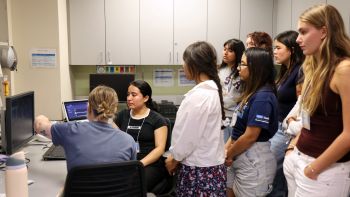Recently, the UCLA Center for the Developing Adolescent brought together researchers, youth engagement practitioners, funders, and members of our Youth National Scientific Council on Adolescence (YNSCA) for a day-long meeting dedicated to enhancing youth engagement across domains.
Co-Executive Director Dr. Andrew Fuligni kicked off the meeting, asking “How can developmental science help inform youth engagement, and how can youth engagement in turn help inform the developmental science of adolescence?”
The activities and conversations that followed were guided by Dr. Ahna Suleiman, Coordinator of the Youth National Scientific Council on Adolescence (YNSCA) and Patricia Marino Price from Hopelab. Some of the discussions tackled tackled these three key questions:
1. How can science inform, change, or challenge how youth and adults partner most effectively?
Currently, there is still distance between what researchers know about adolescent development and how those who work with youth use those principles in their work. The distance can be due to practitioners lacking of access to the science and also due to the science not feeling relevant to their work.
“How do we actually make this [science] real for people for whom the consequences actually matter?” asked NSCA member Dr. Anthony Burrow, Associate Professor of Life-Course Studies at Cornell University.
Discussions explored how an accurate understanding of adolescent development could help create more effective interventions for youth and give young people and those they work with more accurate expectations about what youth can do—including an understanding of youths’ capacity to contribute.
“Youth go through a lot of transitions, either finding new friends, going to new schools,” said YNSCA member Isabel Ohakamma. “Science helps us understand how youth manage those transitions and how other people in their lives can support them through those transitions.”
2. What helps or gets in the way of connecting science?
Dr. Emily Ozer, Professor of Public Health at UC Berkeley, pointed out that methods of collecting data and applying research have to fit with the realities of youth and those who work with them. “If our standards of evidence are only about randomized control trials,” she said, “that’s a challenge due to the issues of the reality on the ground right now, of trying to serve students in the multiple crises we’re dealing with.”
In addition to recognizing the realities of those working with youth, researchers also need to build trust with different communities about how information about these groups is collected and applied. Part of building trust is ensuring that communities that have traditionally been marginalized are represented among those doing the research.
The other major barrier discussed was that research often exists behind paywalls of science journals, written in language that only a seasoned scientist may understand. Connecting developmental science with those who can use it requires jargon-free communication that is usable, relevant, and accessible to the audiences we’re trying to reach.
“In high school, science is very boring,” said Isabel. “Having to read papers can be very boring for the youth we’re trying to engage. The space isn’t relatable to them, they don’t get most of the words or most of the lingo.”
Effective communication is not just about readability. It includes delivery of messages through channels that key audiences use in ways that they want to use.
3. What is needed for science to enhance our work in youth engagement?
There were an abundance of ideas about concrete steps we can take to ensure that science and youth engagement efforts benefit each other. We need to combine theory and practice. We need skilled translators who can discuss the science and how it can be used. We need to ensure that youth and the adults they work with have enough support to ensure that youth engagement benefits everyone involved. We need to continue these conversations between scientists, youth, and those who work to support young people.
— — —
Effective youth engagement that benefits both adults and young people is not always easy, but it is possible. The meeting kicked off conversations, solutions, and partnerships that could help sustain the link between developmental science and youth engagement.
“What’s been encouraging to me is that we all know people who are already doing this,” Andrew concluded. “A lot of this is happening already. If it’s not, how can we set up systems by which we can support it?”
Some examples of how developmental science can inform diverse youth engagement efforts:
- Applying a Developmental Lens to Youth-Led Participatory Action Research: A Critical Examination and Integration of Existing Evidence, by Ahna Ballonoff Suleiman, Parissa J. Ballard, Lindsay Till Hoyt, and Emily J. Ozer, Youth & Society, 2021
- How Adolescent Brain Science Supports Youth Engagement in Court Hearings and Case Planning, American Bar Association, 2019
- “From Context to Outcomes: A Thriving Model for 4-H Youth Development Programs,” by Mary E. Arnold, Journal of Human Sciences and Extension, 2018.

_770_433_80_c1.jpg)

